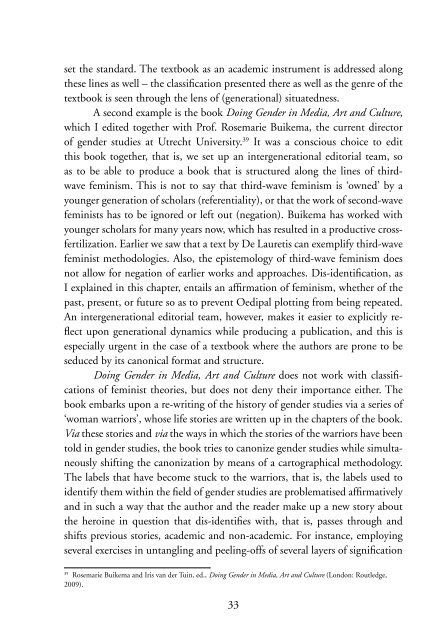Teaching with the third wave new feminists - MailChimp
Teaching with the third wave new feminists - MailChimp
Teaching with the third wave new feminists - MailChimp
Create successful ePaper yourself
Turn your PDF publications into a flip-book with our unique Google optimized e-Paper software.
set <strong>the</strong> standard. The textbook as an academic instrument is addressed along<strong>the</strong>se lines as well – <strong>the</strong> classification presented <strong>the</strong>re as well as <strong>the</strong> genre of <strong>the</strong>textbook is seen through <strong>the</strong> lens of (generational) situatedness.A second example is <strong>the</strong> book Doing Gender in Media, Art and Culture,which I edited toge<strong>the</strong>r <strong>with</strong> Prof. Rosemarie Buikema, <strong>the</strong> current directorof gender studies at Utrecht University. 39 It was a conscious choice to editthis book toge<strong>the</strong>r, that is, we set up an intergenerational editorial team, soas to be able to produce a book that is structured along <strong>the</strong> lines of <strong>third</strong><strong>wave</strong>feminism. This is not to say that <strong>third</strong>-<strong>wave</strong> feminism is ‘owned’ by ayounger generation of scholars (referentiality), or that <strong>the</strong> work of second-<strong>wave</strong><strong>feminists</strong> has to be ignored or left out (negation). Buikema has worked <strong>with</strong>younger scholars for many years now, which has resulted in a productive crossfertilization.Earlier we saw that a text by De Lauretis can exemplify <strong>third</strong>-<strong>wave</strong>feminist methodologies. Also, <strong>the</strong> epistemology of <strong>third</strong>-<strong>wave</strong> feminism doesnot allow for negation of earlier works and approaches. Dis-identification, asI explained in this chapter, entails an affirmation of feminism, whe<strong>the</strong>r of <strong>the</strong>past, present, or future so as to prevent Oedipal plotting from being repeated.An intergenerational editorial team, however, makes it easier to explicitly reflectupon generational dynamics while producing a publication, and this isespecially urgent in <strong>the</strong> case of a textbook where <strong>the</strong> authors are prone to beseduced by its canonical format and structure.Doing Gender in Media, Art and Culture does not work <strong>with</strong> classificationsof feminist <strong>the</strong>ories, but does not deny <strong>the</strong>ir importance ei<strong>the</strong>r. Thebook embarks upon a re-writing of <strong>the</strong> history of gender studies via a series of‘woman warriors’, whose life stories are written up in <strong>the</strong> chapters of <strong>the</strong> book.Via <strong>the</strong>se stories and via <strong>the</strong> ways in which <strong>the</strong> stories of <strong>the</strong> warriors have beentold in gender studies, <strong>the</strong> book tries to canonize gender studies while simultaneouslyshifting <strong>the</strong> canonization by means of a cartographical methodology.The labels that have become stuck to <strong>the</strong> warriors, that is, <strong>the</strong> labels used toidentify <strong>the</strong>m <strong>with</strong>in <strong>the</strong> field of gender studies are problematised affirmativelyand in such a way that <strong>the</strong> author and <strong>the</strong> reader make up a <strong>new</strong> story about<strong>the</strong> heroine in question that dis-identifies <strong>with</strong>, that is, passes through andshifts previous stories, academic and non-academic. For instance, employingseveral exercises in untangling and peeling-offs of several layers of signification39Rosemarie Buikema and Iris van der Tuin, ed., Doing Gender in Media, Art and Culture (London: Routledge,2009).33
















